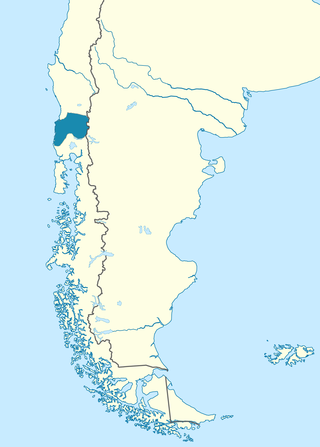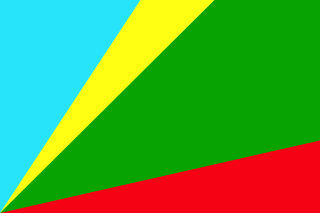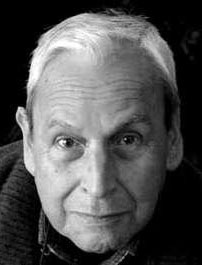
Huilliche is a moribund branch of the Araucanian language family. In 1982 it was spoken by about 2,000 ethnic Huilliche people in Chile, but now it is only spoken by a few elderly speakers. It is spoken in the nation's Los Lagos and Los Ríos regions; and mountain valleys, between the city of Valdivia and south toward the Chiloé Archipelago.

Mapuche ; from mapu 'land' and dungun 'speak, speech') is an Araucanian language related to Huilliche spoken in south-central Chile and west-central Argentina by the Mapuche people. It is also spelled Mapuzugun and Mapudungu. It was formerly known as Araucanian, the name given to the Mapuche by the Spaniards; the Mapuche avoid it as a remnant of Spanish colonialism.

The Huilliche, Huiliche or Huilliche-Mapuche are the southern partiality of the Mapuche macroethnic group in Chile and Argentina. Located in the Zona Sur, they inhabit both Futahuillimapu and, as the Cunco or Veliche subgroup, the northern half of Chiloé Island. The Huilliche are the principal indigenous people of those regions. According to Ricardo E. Latcham the term Huilliche started to be used in Spanish after the second founding of Valdivia in 1645, adopting the usage of the Mapuches of Araucanía for the southern Mapuche tribes. Huilliche means 'southerners' A genetic study showed significant affinities between Huilliches and indigenous peoples east of the Andes, which suggests but does not prove a partial origin in present-day Argentina.

Puerto Montt is a port city and commune in southern Chile, located at the northern end of the Reloncaví Sound in the Llanquihue Province, Los Lagos Region, 1,055 km to the south of the capital, Santiago. The commune spans an area of 1,673 km2 (646 sq mi) and has a population of 245,902 in 2017. It is bounded by the communes of Puerto Varas to the north, Cochamó to the east and southeast, Calbuco to the southwest and Maullín and Los Muermos to the west.

Valdivia is a city and commune in southern Chile, administered by the Municipality of Valdivia. The city is named after its founder, Pedro de Valdivia, and is located at the confluence of the Calle-Calle, Valdivia, and Cau-Cau Rivers, approximately 15 km (9 mi) east of the coastal towns of Corral and Niebla. Since October 2007, Valdivia has been the capital of Los Ríos Region and is also the capital of Valdivia Province. The national census of 2017 recorded the commune of Valdivia as having 166,080 inhabitants (Valdivianos), of whom 150,048 were living in the city. The main economic activities of Valdivia include tourism, wood pulp manufacturing, forestry, metallurgy, and beer production. The city is also the home of the Austral University of Chile, founded in 1954 and the Centro de Estudios Científicos.

Zona Sur is one of the five natural regions on which CORFO divided continental Chile in 1950. Its northern border is formed by the Bío-Bío River, which separates it from the Central Chile Zone. The Southern Zone borders the Pacific Ocean to the west, and to the east lies the Andean mountains and Argentina. Its southern border is the Chacao Channel, which forms the boundary with the Austral Zone. While the Chiloé Archipelago belongs geographically to the Austral Zone in terms of culture and history, it lies closer to the Southern Zone.

Teja island is an island in the city of Valdivia, Chile, surrounded by three rivers: Cau-Cau river to the north, Cruces river to the west and Valdivia river to the southeast. Prior to the mid-19th century, the island was known as isla Valenzuela after Francisco de Valenzuela, an encomendero that settled there in 1552. In the second half of the 19th century, the island became known for its roof tile and brick factory, hence the name isla Teja. Initially it was outside the proper city, but with the arrival of German immigrants, many of them settled there, and since 1939, the island is directly connected to downtown Valdivia through the Pedro de Valdivia bridge. A large section of the island's western riverside sank below water level due to the Great Chilean earthquake of 1960.
Claudio Donoso Zegers was a Chilean forester, teacher and professor emeritus at the Austral University of Chile in Valdivia. Donoso was among the first to define the different forest types of Chile when he released the book Tipos forestales de los bosques nativos de Chile in cooperation with CONAF in 1981. This typology became later official by its use in Chilean law. From 1980 to 1981 he was co-editor of Bosque, a forestry scientific journal published by the Austral University of Chile. He retired in 2000 becoming a professor emeritus.
Bosque is a scientific journal published by the Forestry Faculty of the Southern University of Chile. It publishes articles on a wide range of forestry-related topics, primarily on issues that are relevant to Chile, Latin America and the Southern Hemisphere. The published articles include peer-reviewed scientific research papers, items of current interest and opinion pieces. Bosque's first issue was published in 1975 and the journal was issued yearly until 1985. From 1985 to 2003 it was issued twice a year and from 2003 on three times a year. The topics covered in Bosque are management and production of forestry resources, wood science and technology, silviculture, forest ecology, natural resources conservation, and rural development associated with forest ecosystems. The journal publishes research articles, notes and opinions, both in Spanish and English. Bosque was included in the Science Citation Index Expanded in 2009. The journal is also indexed in The Zoological Record.
María Catrileo Chiguailaf de Codo is a native Mapuche linguist and professor of Spanish, English and Mapudungun language.

José Gregorio Liendo Vera, also known as "Compañero Pepe", "Comandante Pepe" or "Loco Pepe" was a Chilean university student, political leader, and militant of the Revolutionary Left Movement, a Marxist-Leninist and Guevarist urban guerrilla and political movement. He was also a leader and a member of the "Movimiento Campesino Revolucionario" (MCR), the MIR's Front of the Masses among the Chilean peasantry, which participated in the fundos occupations during the government democratically elected socialist President Salvador Allende and served with the leftist political coalition Unidad Popular in the early 1970s.

Guido Mutis Carrasco was an English literature professor at the Valdivia campus of the Austral University of Chile and director of the Valdivia International Film Festival. During his life he made important contributions to national cinema studies and Chilean literature.
From 1850 to 1875, some 30,000 German immigrants settled in the region around Valdivia, Osorno and Llanquihue in Southern Chile as part of a state-led colonization scheme. Some of these immigrants had left Europe in the aftermath of the German revolutions of 1848–49. They brought skills and assets as artisans, farmers and merchants to Chile, contributing to the nascent country's economic and industrial development.
As an archaeological culture, the Mapuche people of southern Chile and Argentina have a long history which dates back to 600–500 BC. The Mapuche society underwent great transformations after Spanish contact in the mid–16th century. These changes included the adoption of Old World crops and animals and the onset of a rich Spanish–Mapuche trade in La Frontera and Valdivia. Despite these contacts Mapuche were never completely subjugated by the Spanish Empire. Between the 18th and 19th century Mapuche culture and people spread eastwards into the Pampas and the Patagonian plains. This vast new territory allowed Mapuche groups to control a substantial part of the salt and cattle trade in the Southern Cone.
The origin of the Mapuche has been a matter of research for over a century. The genetics of the Mapuche do not show overly clear affinities with any other known indigenous group in the Americas, and the same goes for linguistics, where the Mapuche language is considered a language isolate. Archaeological evidence shows Mapuche culture has existed in Chile at least since 600 to 500 BC. Mapuches are late arrivals in their southernmost and easternmost (Pampas) areas of settlement, yet Mapuche history in the north towards Atacama Desert may be older than historic settlement suggest. The Mapuche has received significant influence from Pre-Incan (Tiwanaku?), Incan and Spanish peoples, but deep origins of the Mapuche predates these contacts. Contact and conflict with the Spanish Empire are thought by scholars such as Tom Dillehay and José Bengoa to have had a profound impact on the shaping of the Mapuche ethnicity.
The Jorge Millas Award was instituted in 1996 to remember the work of the distinguished intellectual Jorge Millas (1917–1982), an academic at the University of Chile and dean of the Faculty of Philosophy and Social Sciences of the Austral University of Chile.
Chan Chan was a dense forest that existed between Osorno and La Unión in Southern Chile. The forest was intionally put on fire in the summer of 1851 by order of Chilean colonization agent Vicente Pérez Rosales. Pichi Juan, a native Huilliche was tasked with setting the forest afire. Pichi Juan did so by starting fires at multiple locations. According to Pérez Rosales Pichi Juan barely escaped death by hiding inside the trunk of a Nothofagus dombeyi.

Rosa Catrileo Arias is a Mapuche lawyer and politician who serves as a member of the Chilean Constitutional Convention. As an attorney, she has primarily focused on protecting indigenous land rights in the Mapuche conflict.
Victorino Ernesto Antilef Ñanco is a Mapuche educator and politician in Chile. In 2021, Antilef was elected to the Chilean Constitutional Convention to represent the Mapuche people, who are entitled to seven reserved seats on the newly formed body.















